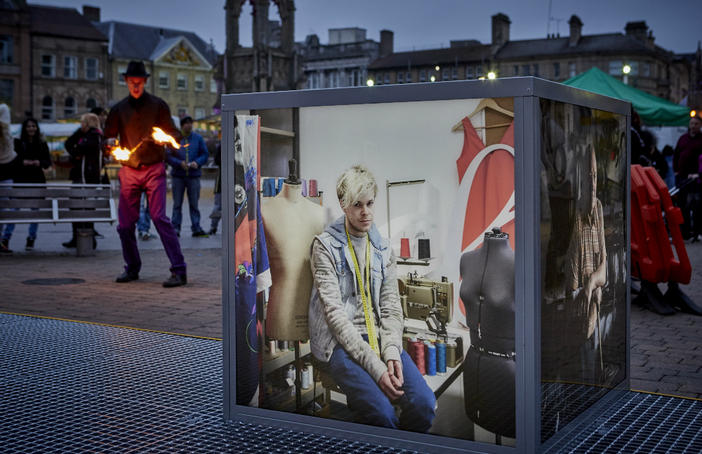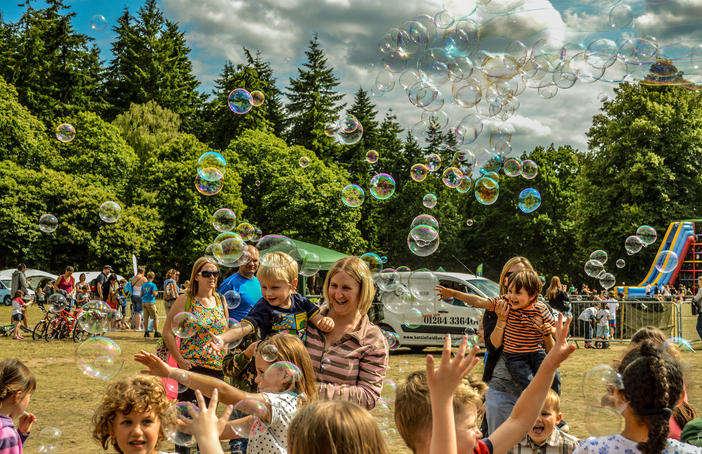Blog Post
Building arts engagement in rural areas
First Art, Market Place and Transported discuss the challenges and opportunities of building arts engagement in rural areas

Several Creative People and Places projects work across large rural areas. Eleanor Turney talks to people working on three such projects about the artistic and logistical challenges they face and how they tackle them.
Elaine Knight and Nick Jones run Transported, which operates in and around Boston and South Holland in Lincolnshire. Kate Hall manages Market Place, which works across the market towns of March, Whittlesey, Chatteris, Wisbech, Brandon, Newmarket and Mildenhall. Paul Steele is a lead for First Art in North East Derbyshire, Bolsover, Ashfield and Mansfield.
These three CPP projects may be operating in different parts of the country and in different contexts, but they face many of the same opportunities and challenges.
Battling infrastructure
The first thing that all of the projects mention is the importance of understanding transport and infrastructure outside cities. Elaine Knight of Transported explained: “We have a couple of large market towns with lots of open fields and villages and not much else in between. Wifi is intermittent, and it’s difficult for the different towns and villages to connect up with each other.” Transported works to find ways to connect these disparate areas and communities through the arts.
Kate Hall of Market Place points out in her area that “there’s very little infrastructure, not just in the arts but across the board. Three of the towns I work with don’t have a station. Lots of people rely on public transport but only have a service every few hours, so it mostly means they just stay where they are.”
And yet, Market Place works across this huge area and works with communities who have “incredibly ambitious” ideas. “My process is: build on the infrastructure that’s there, don’t try to build it yourself. I might try to build some infrastructure at some point, but whilst we’re trying to take these baby steps, work off what’s there, don’t try and invent the wheel, because all you’re doing is inventing something that might not be sustainable.”
Paul Steele explains that there isn’t much infrastructure in the area covered by First Art, with the exception of Mansfield. “The biggest challenge is that if we want to bring anything of scale, it’s finding where it can go! We have to start from scratch, basically. Even if we did manage to put on something large-scale, it’s a long way from one end of the district to the other. The nearest cities are Sheffield, which obviously has a good arts infrastructure, and then Nottingham and Derby, but the people we’re working with tend not to travel. The transport infrastructure is very poor. The idea is to take art out to different places.”
Finding a way in
Kate Hall mentions the challenge that “there are no professional, funded arts organisations. There’s lots of community activity, but I wouldn’t necessarily call it arts activity.” However, the communities in which Market Place works are enthusiastically working with CPP to build up their arts offer.
“The way the programme was set up, there’s a creative forum in each town – a group asking what arts activity people want to see in their area. Each one of those is different. I sat round a table in Chatteris a few weeks ago, and they were all artists. The project those artists were responding to was shaped by things that the community members who’d been there before had described, and then I went, okay, this is how we can start…”
Hall continues: “It’s really important that the people who do things in those towns come forward, and describe their dreams and hopes, and what their town is like. Quite often they simply can’t deliver what they want. My argument is always if they could, they would have done – it would be happening already. And actually, a lot of them are on the Chatteris in Bloom committee and carnival committee and it’s lots of the same people who are really driving those communities, and they just can’t take on anything else. But they are often the most informed. What we’ve got to try and do with the next projects that we’re rolling out is to start drawing out other people who can start to take ownership and drive things forward.”
Paul Steele tells me a lovely story: “During our Bolsover Stories festival two elderly ladies attended the Friday night performance of 'Bolsover Bingo’. I'm not sure they understood at first that it was a theatrical performance and interactive game but during the performance they seemed to experience emotions from surprise and astonishment to delight and appreciation. The great thing was that the same two ladies then came to the following day’s activities before returning to the following evening's repeat performance of Bolsover Bingo, bringing along their families and friends. When asked why they had come for a second night they responded they ‘had not seen anything like this before and they wanted to share it with their friends and family’.”
Choosing a location
Paul Steele also raises this challenge: “Taking Mansfield out of the equation, there are no theatres or arts venues in Ashfield, Bolsover or North East Derbyshire. There’s a theatre in Mansfield, and a museum, because it’s a bigger town, but in terms of venues there aren’t really any others.” However, for First Art, this means thinking creatively, and finding new places to display and perform artworks.
“The idea is to take art out to different places. When we first started, we worked with a Portuguese company who make light boxes. We commissioned photographers to create portraits of local people and those were placed in the centre of Mansfield. We negotiated to get this light box exhibition before it went down to Somerset House in London – so we got its UK debut in Mansfield. We felt that that was really what CPP was about – giving people in the area the opportunity to see this work, and then after that it went to London and on a European tour. So, it’s absolutely about trying to give people the chance to access and experience that level of work, rather than having to travel out of the area and into the cities.”
First Art have tried to make the work as accessible as possible – by putting it outdoors in the town centre, rather than in a gallery or exhibition space. The light boxes in Mansfield, for example: “people could climb on them, sit on them – we had people riding bikes on them. They were totally accessible. No barriers, you could walk right up.”
Try something new
Paul Steele also tells me: “We’ve tried touring things – we recently did a project with Manchester Camerata and Orchestras Live, to put on an orchestral tour. It worked really well. We toured it to four venues, one in each of the districts. We’ve looked at touring other things. The issue is about having the critical mass of activity to build up an audience. It’s very difficult. If we had one city or one specific area to concentrate activity on, you feel that you could build a programme over, say, three years that builds audience and has genuine audience development. The challenge we’ve got is to do that across a really wide area with a limited budget. So what we’re doing is pinpointing places, and doing that in certain places, and then trying to deliver smaller projects and audience development around events, that then drive an audience towards the bigger showcase events.”
Nick Jones has the same attitude in south Lincolnshire: “We don’t have the buildings – we only have one funded arts centre. There are a couple of smaller galleries, and a theatre in Boston, and other venues that have been supported in the past by local authorities have closed. It’s really important that there is a different approach to providing opportunities for people to take part. Our approach is obviously to take it into those villages – the arts does the travelling rather than the audiences.”
Forging new partnerships
In Transported’s case, that’s meant working in partnership with local businesses. “It’s about finding the partners in the places where they can be useful and who are in a position to work with you and who want to work with you. Businesses in this case had the resources to support the work we wanted to do.”
“We took art projects into two workplaces, one a haulage company and one a seed company. One had a contemporary dance residency and performance, which blew people’s socks off because they would never have done anything like that before. All the feedback was that it was moving and transformative. With the haulage company, we put art on the side of lorries and the artists went to worked with the pickers and packers, and talked to them about being in the landscape and asking where are the most beautiful bits of the Lincolnshire landscape.
"The chief executives of these companies heard back from their managers that morale in the workplace had dramatically improved, we’ve got people talking about wanting to stay with the company because it demonstrates a level of care, or people turning up for job interviews because they’ve seen the haulage artworks… that’s led us to feel confident about developing something that can definitely reach new arts audiences and engagers, but also maybe contribute to hard-headed business objectives, too.”
What’s next?
Kate Hall raises an interesting point: “I think the impact of cuts in infrastructure makes it even harder – and at the same time produces an opportunity. On the one hand, infrastructure is being cut away and various things are closing down and no longer available. On the other hand, it opens up an opportunity to say ‘What’s the role of the arts?’ The cuts feel very deep out in these regions, but because the communities are very strong there’s actually something to respond to, there’s an opportunity. But I think it’s harder than I’m making it sound. I think what’ll be interesting is that the Arts Council’s Grants for the arts funding is changing, so it’ll be easier for individual artists to apply. I think that could have quite a big impact in rural areas if there’s investment to try and encourage those artists to apply.”
Paul Steele’s advice for other projects is: “Begin with what's there (dig where you stand!), build on the themes and stories of the area as this will engage people initially and then introduce new perspectives and artistic ambition. Also, always start by building relationships with local people. The districts where we work have a history of regeneration-funded projects and people grow tired of funded programmes parachuted in. The key is to embed the programme within the area and communicate early on that local people have genuine choice and opportunity within the programme.”









